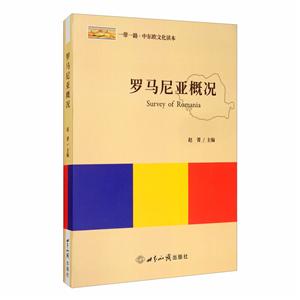-
>
兩種文化之爭 戰(zhàn)后英國的科學(xué)、文學(xué)與文化政治
-
>
東方守藝人:在時間之外(簽名本)
-
>
易經(jīng)
-
>
辛亥革命史叢刊:第12輯
-
>
(精)唐風(fēng)拂檻:織物與時尚的審美游戲(花口本)
-
>
日本禪
-
>
日本墨繪
羅馬尼亞概況 版權(quán)信息
- ISBN:9787501262007
- 條形碼:9787501262007 ; 978-7-5012-6200-7
- 裝幀:一般膠版紙
- 冊數(shù):暫無
- 重量:暫無
- 所屬分類:>
羅馬尼亞概況 內(nèi)容簡介
這是一套由北京市第二外國語大學(xué)英語學(xué)院組織編寫“一帶一路”沿線國文化書系之一。其中包括波蘭、捷克、斯洛伐克、匈牙利、斯洛文尼亞、克羅地亞、羅馬尼亞、保加利亞、塞爾維亞、黑山、馬其頓、波黑、阿爾巴尼亞、愛沙尼亞、立陶宛、拉脫維亞共16個成員國。各冊十章左右,字數(shù)約10-15萬字,分別按地理(包括主要城市介紹、旅游資源,如世界文化遺產(chǎn)等的介紹)、歷史、語言、政治、經(jīng)濟、教育、文學(xué)、音樂、舞蹈、繪畫、體育、習(xí)俗、節(jié)慶活動等內(nèi)容編排,并配有高清圖片。
羅馬尼亞概況 目錄
Chapter 2 History
Chapter 3 Climate and Environment
Chapter 4 Culture and Customs
Chapter 5 SocialLife
Chapter 6 Government and Politics
Chapter 7 Economy and Trade
Chapter 8 Transportation and Commu:cucations
Chapter 9 Education
Chapter 10 Religion
Chapter 11 Sports and Outdoor Activities
Chapter 12 Entertainment
Chapter 13 Current Issues and Challenges
羅馬尼亞概況 節(jié)選
The reign of Stephen the Great in Moldavia(1457-1504) was one of the high points for Romanian ecclesiastical architecture.He built more than 30 churches and monasteries, many of which were in southern Bucovina and subsequently painted on their exterior as well as interior walls.The "painted monasteries" of Moldovita, Sucevita and Voronet are renowned for the brilliant colours and striking images of their exterior frescoes portraying Genesis, the Tree of Jesse, the Last Judgment and the siege of Constantinople.Moldavian church architecture experienced another great period in the 17th century with the construction of the monasteries of Dragomima(1609) and Trei lerarhi(1639),notable for their omate lacework facades.During the 17th and 18th centuries,the closer relations between the two Danubian Principalities were reflected in greater similarity oftheir church architecture.Due to the unsettled conditions in the Danubian Principalities, moreimportant secular buildings survived from earlier times in Transylvania.In the Gothic style, these include the town hall in Sibiu and the castles in Hunedoara(of which a partial replica exists in the Budapest city park since the late 19th century) and Bran in the Carpathians south of Brasov.With its angular shape and prominence along the highway to Bucharest, Castle Bran is sometimes referred to as "Dracula's Castle" despite its tenuous connection with Vlad the Impaler.Renaissance monuments in Transylvania include private houses in Cluj and Sibiu and the royal fortress in the middle of the southern Transylvanian town of Fagaras.Sibiu, whose Saxon inhabitants have largely emigrated, is architecturally the largest German town in Southeastem Europe, with a partially intact city wall and characteristic window vents known as roof eyes(Dachaugen)on the pitched roofs of older buildings.In the Principalities, the major 16th-century fortress of Piatra Neamt in Moldavia has survived, but there are only ruins from the Walachian princely courts in Targoviste and Bucharest.There were regional styles in the domestic architecture of the common people.The porches in Brancovenesc buildings may have arisen in imitation of Romanian homes.At the end of the 19th century, professional architects began to take more notice of popular styles and attempted a synthesis of folk and modern architecture in their work.The leading representative of this tendency in Romania was Ion Mincu, who built various restaurants and private homes in Bucharest and restored the Stavropoleos Church in 1906.The Transylvania Hungarian Karoly Kos studied in Budapest, where he became an advocate of a style that resembled Mincu's in its objectives but sought to revive Hungarian regional styles.His most notable building is the Szekely National Museum in Sfantu Gheorghe.The Palace of Culture in Targu Mures is another example of Hungarian folk revival architecture, whereas the National Theater in Cluj is an example of Habsburg art nouveau.Many Bucharest houses and even apartment buildings of the interwar period are examples of these styles.After 1920, Kos and the Bucharest sociologist Dimitrie Gusti worked independently for the preservation of folk architecture.Kos published a highly regarded collection of meticulous drawings of Transylvanian village architecture in 1929, while in1936 Gusti founded the remarkable Village Museum in Bucharest that is a collection of village houses and wooden churches from all over the country.It was the third open-air museum of its type in Europe.The Museum of the Romanian Peasant arose from earlier institutions founded in 1875 and 1906 -1912.It was associated with the Village Museum after 1978 but became an independent institution once more in 1990. ……
羅馬尼亞概況 作者簡介
趙菁,北京第二外國語學(xué)院英語學(xué)院副教授,英語語言及文學(xué)碩士,2015-2017年留學(xué)美國阿巴拉契亞州立大學(xué)。研究方向:教育學(xué)、跨文化研究、翻譯研究。近年來,在國內(nèi)各類學(xué)術(shù)刊物發(fā)表論文10余篇、主編教材3部、翻譯著作侶部、參與國家及市級項目2項。
- >
龍榆生:詞曲概論/大家小書
- >
羅曼·羅蘭讀書隨筆-精裝
- >
月亮與六便士
- >
姑媽的寶刀
- >
隨園食單
- >
【精裝繪本】畫給孩子的中國神話
- >
中國人在烏蘇里邊疆區(qū):歷史與人類學(xué)概述
- >
伯納黛特,你要去哪(2021新版)

















